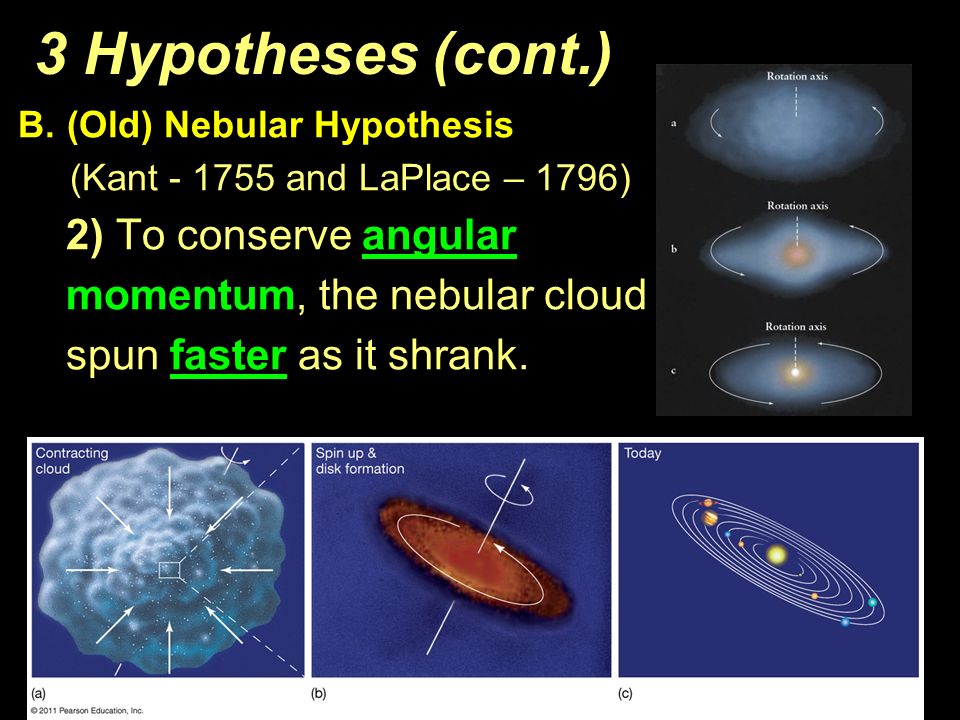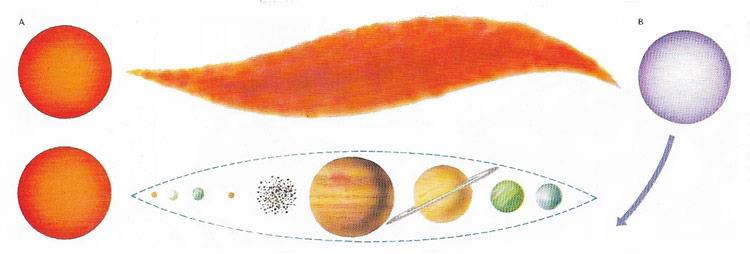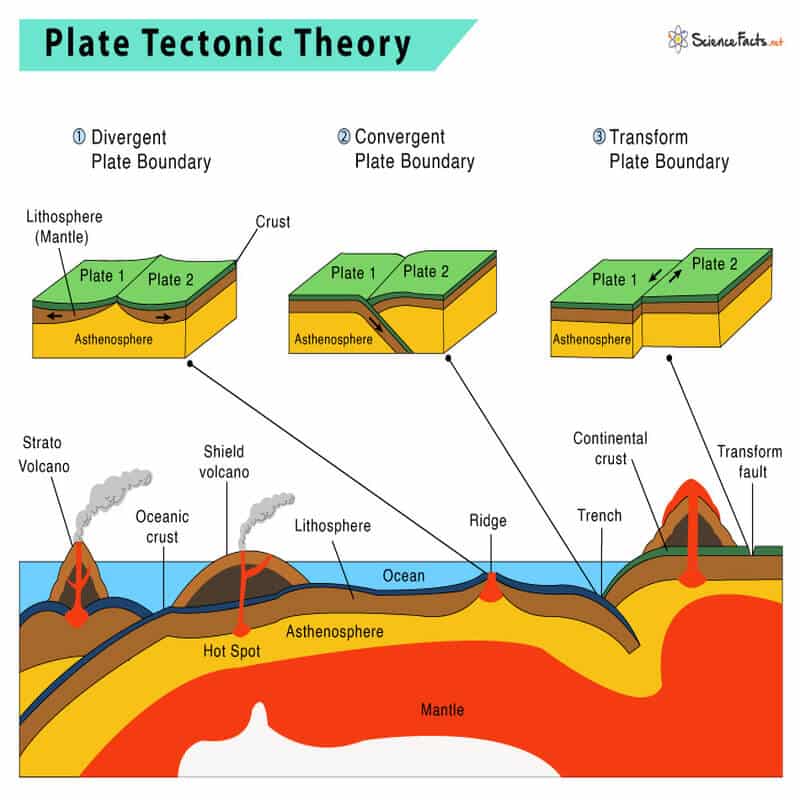Theories about origin of Earth
A. Nebular hypothesis (Kant and Laplace, 1755)
- Proposed by Immanuel Kant (1755).
- Later refined by Pierre-Simon Laplace
- Widely accepted explanations for the formation of the solar system.

Core Concept
- The solar system originated from a hot, rotating gaseous mass called a nebula.
- This nebula cooled over time, leading to the formation of planets through a process of condensation and contraction.
Step-by-Step Formation
a. Initial Nebula
- The solar system began as a massive, hot gaseous cloud—the nebula.
- It was primarily composed of hydrogen, helium, and other cosmic materials.
b. Cooling & Contraction
- As the nebula cooled, it contracted and increased its rotation speed (due to conservation of angular momentum).
- A bulge formed around the equatorial region.
c. Ring Formation
- The bulge split into several concentric rings.
- These rings eventually condensed to form planetary bodies.
d. Planet Formation
- Outer planets formed first, followed by the inner planets.
- Sequence: Jupiter & Saturn → Mars → Earth & Venus → Mercury.
- The outer planets (Jovian planets) are mostly gaseous, while the inner planets (Terrestrial planets) became rocky and dense.
e. Planetoid Formation
- One of the rings fragmented into smaller bodies—the asteroids (planetoids).
f. Sun Formation
- The central mass of the nebula remained intact and became the Sun, the primary energy source for the solar system.
Limitations
- Despite its historical significance, the Nebular Hypothesis faced scientific challenges:
- It couldn’t explain the Sun’s angular momentum discrepancy.
- Newer models like the Protoplanetary Disk Model and the Solar Nebula Theory offer more detailed insights into the formation process.
B. Planetismal hypothesis (Chamberlain and Moulton, 1905)
- Proposed by Chamberlain and Moulton in 1905.
- Presents a biparental origin of the solar system, suggesting that planets formed through the interaction of the Sun with a passing star.

Core Concept
- The solar system was formed when a massive star passed close to the Sun, causing gravitational disturbances.
- This interaction led to the ejection of solar material that cooled, condensed, and coalesced into planetesimals, which later formed planets.
Step-by-Step Formation
a. Close Stellar Encounter:
- A large star passed near the Sun, generating strong tidal forces.
- These forces distorted the Sun’s surface, triggering massive eruptions (like solar prominences).
b. Ejection of Solar Material
- Gaseous solar material was ejected into space as solar bulbs.
- These ejected materials cooled rapidly, forming tiny solid particles called planetesimals.
c. Planetesimal Accretion
- The planetesimals orbited the Sun in elliptical paths.
- Over time, they collided and coalesced, growing into larger bodies—the planets.
d. Formation of Planets
- As collisions increased, heat was generated but dissipated quickly, allowing solid planets to form.
- Successive collisions caused some melting of planetary masses, leading to their differentiated internal structure.
Key Insights
- Planetesimals are tiny solid particles formed from solar material.
- The solar system formation involved a two-star interaction (biparental origin).
- Planets grew through a process of collisions, accretion, and coalescence.
Strengths
- Provided a plausible explanation for the formation of solid planets.
- Explained the elliptical orbits of planetesimals.
Limitations
- Unlikely close encounters between stars are extremely rare.
- Could not explain angular momentum distribution in the solar system.
- Modern models like the Solar Nebula Theory and Protoplanetary Disk Model are now more widely accepted.
C. Gaseous Tidal Hypothesis
- Proposed by Sir James Jeans and Harold Jeffreys in 1925.
- Provides a biparental origin of the solar system, similar to the Planetesimal Hypothesis, but excludes the Sun’s internal eruptive forces as a factor in planet formation.

Core Concept
- A massive passing star exerted a gravitational tidal pull on the Sun.
- This interaction pulled out a gaseous mass, which later fragmented and condensed into planets.
Step-by-Step Formation
a. Close Stellar Encounter
- A massive star passed close to the Sun, generating intense gravitational forces.
- This caused a tidal bulge to form on the Sun’s surface.
b. Ejection of Gaseous Mass
- As the passing star receded, the tidal bulge detached, forming a spindle-shaped mass.
- This spindle was thicker at the center and tapered at both ends.
c. Fragmentation of Spindle
- The spindle-shaped gaseous mass was unstable and broke into pieces.
- Nine pieces formed the planets and the tenth fragmented into planetoids.
d. Planet Formation
- These gaseous fragments began to cool and condense.
- Over time, they solidified, forming planets revolving around the Sun in co-planar orbits.
Key Insights
- The planets formed from a spindle-shaped mass of gas.
- Tidal interactions between the Sun and a passing star were key to planet formation.
- Explains the co-planar orbits and density variations within planets.
Strengths
- Simple and elegant explanation for planetary orbits.
- Explains density stratification and mass distribution within the solar system.
Limitations
- Close stellar encounters are highly improbable in modern astrophysics.
- Does not adequately explain the formation of moons and smaller bodies.
- The spindle-shaped mass formation is considered mechanically unstable.
Modern Perspective
- The Gaseous Tidal Hypothesis has been largely superseded by the Nebular Hypothesis and Protoplanetary Disk Model, which better align with observational data and modern physics.
D. Tectonic Plate Theory
- Explains the movement of Earth’s lithosphere—the rigid outer shell of the Earth—over the semi-fluid asthenosphere.

Key Components
- Lithosphere
- Composed of the crust and the uppermost mantle.
- Broken into tectonic plates that float on the asthenosphere.
- Asthenosphere
- A ductile, semi-fluid layer beneath the lithosphere.
- Provides the mechanical support for plate movement.
Major Tectonic Plates
- Pacific Plate (largest)
- North American Plate
- Eurasian Plate
- Antarctic Plate
- African Plate
- Indo-Australian Plate
- South American Plate
- Plus numerous minor plates like the Juan de Fuca, Nazca, and Philippine Sea Plate.
Plate Movements (Plate Tectonics)
Tectonic plates interact at boundaries, which influence earthquakes, volcanoes, mountain formation, and oceanic trench development.
- Convergent Boundaries – Plates collide → Mountains or Subduction Zones.
- Divergent Boundaries – Plates move apart → Mid-ocean ridges or rift valleys.
- Transform Boundaries – Plates slide past each other → Fault lines (e.g., San Andreas).
E. Continental Drift Theory
- Proposed by Alfred Wegener in 1912,
- Suggests that the Earth’s continents are in constant motion, drifting across the planet’s surface over millions of years.

Key Concepts
a. Pangaea: The Supercontinent
- 200 million years ago (Mya): All continents formed one massive landmass called Pangaea.
b. Breaking Apart
- 160 Mya: Pangaea split into two landmasses:
- Laurasia (Northern Hemisphere)
- Gondwana (Southern Hemisphere)
c. India’s Journey 🇮🇳
- 140 Mya: India separated from Gondwana and moved northward.
- Collision with Eurasia → Formation of the Himalayas
d. Australia’s Migration
- 100 Mya: Australia separated from Antarctica and drifted northward.
e. Ocean Dynamics
- Atlantic Ocean widens as continents move apart.
- Pacific Ocean shrinks due to plate movements.
Continents in Motion (Present & Future)
- Atlantic Ocean → Expanding
- Pacific Ocean → Shrinking
- Himalayas → Still rising due to ongoing tectonic collision.
- Australia → Moving northward; expected to cross the equator in 60 million years.
Scientific Explanation
The drift of continents is driven by plate tectonics, specifically:
- Convection currents in the Earth’s mantle.
- Sea-floor spreading at divergent boundaries (like the Mid-Atlantic Ridge).